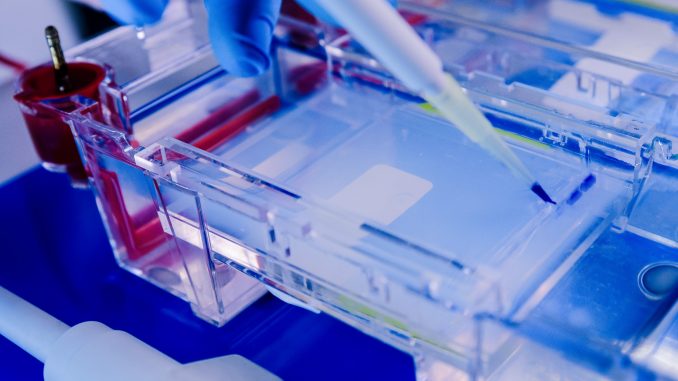
Electrophoresis is one of the key analytical tools available to the biochemist and food scientist for separating and identifying proteins and nucleic acids. We often discuss it as a technique in studies on biomolecules, biopolymers and its been a stalwart analytical method for decades.
The method of separation belongs to those that rely to some extent on size exclusion so it shares some similarities with gel chromatography. One major difference however is that electrophoresis relies on the presence of an electrical charge on the molecule. When these are placed in an electrical field, charged molecules move towards the electrode of opposite charge because of the phenomenon of electrostatic attraction. This is the driving force for the separation.
Electrophoresis has been a key tool in separating and analysing proteins and their fragments, and nucleic acids like DNA and RNA on the basis of charge and size. It is a method for measuring the molecular weight of biopolymers.
To large extent this post will focus on gel electrophoresis because of its versatility but other methods will also be covered.
Types of Electrophoresis
Thee are many different types of electrophoresis. We can divide them into two categories: moving boundary electrophoresis and zone electrophoresis.
The moving boundary electrophoretic methods include capillary electrophoresis, isotachophoresis, isoelectric focusing and immunoelectrophoresis.
Zone electrophoresis includes methods such as paper electrophoresis, gel electrophoresis, thin layer- and methods associated with the medium cellulose acetate.
The Principle of Electrophoretic Separation
Electrophoresis is a separation of charged molecules in an applied electric field. The relative mobility of each molecule depends on a number of factors. These are:-
- net charge
- molecular shape
- the charge to mass ratio
- the type of matrix – its porosity and chemical structure through which the biomolecule must travel.
- the temperature of the system and viscosity of the liquid
The substance is placed in the wells of a gel or other matrix.
Properties of the Sample
Net Charge: When an electric current is applied and electric field is generated and charged molecules will move in accordance with that field. The biomolecule moves through the matrix at different rates towards the anode (positively charged) if the biomolecule is negatively charged or towards the cathode (negatively charged) if positively charged.
When the electric field is strengthened, there is an increase in the potential gradient which increases the rate of migration.
Net Size: The biomolecules move through the gel but each one is restricted as they move through the pores of the medium. The larger molecules are impeded more than the smaller ones so these move faster. The result of this difference in impedance and restricted movement means that the separation is based more or less on molecular size. The larger molecules will not have travelled as far and will be closer to the starting point compared to the smaller ones which are closer to the oppositely charged end-point.
Charge to Mass Ratio
The key ratio to be considered in the charge to mass ratio which dictates electrophoretic mobility. The higher the charge, the greater the electrophoretic mobility. Likewise, the larger the size of the molecule, the slower it moves. Shape also has some impact because globular, more spherical molecules move much quicker than fibrous ones.
The Matrix Used
The matrix or medium needs to be inert. It can serve purely as a molecular sieve where pore size influences rate of migration and through adsorption. Adsorption refers to the degree that biopolymers are retained on the surface of the supporting medium.
Buffers Used
The buffer affects electrophoretic mobility. Mobility is affected by ionic strength and pH. Any increase in ionic strength of the buffer means that a larger share of current is carried by the buffer and a small portion by the sample. Reducing the ionic strength means a diminishing of its impact. The pH determines the degree of ionization of the biomolecules. The degree of ionization is inversely proportional to pH.
Gel Electrophoresis
The method relies on a gel matrix for separation which operates as a medium to suppress movement of biopolymers. Some describe the gel as an anti-convective medium and as a sieve. The gel suppresses thermal convection when the electric field is applied. It also maintains the separation once it has completed so that stains to show up the separated biopolymers can be examined and analysed.
Gel electrophoresis can be carried out vertically or horizontally.
Horizontal Gel Electrophoresis
The gel bed is placed in a horizontal position. Both ends of the bed are connected to an electrophoresis buffer solution but separately. The gel serves as a pocket in which components with a smaller molecular size are trapped. It is easy to separate some of these specific components.
A potential difference is applied across both ends. The components are separated because of their electrophoretic ability.
Observing The Separated Biopolymers
The separated biopolymers in the gel need to be visualised, so made visible and identified.
DNA is stained using ethidium bromide which intercalates with DNA and fluoresces under ultraviolet light. Ethidium bromide is not as safe as using SYBR Green 1 or SYBR Safe which are considerably more sensitive stains.
Proteins are stained using silver stains or Coomassie Brilliant Blue dye.
Applications
Electrophoresis is used to separate a number of biopolymers
- Proteins including lipoproteins and enzymes
- Amino acids
- Antibiotics
- Nucleic acids such as DNA, RNA

Leave a Reply